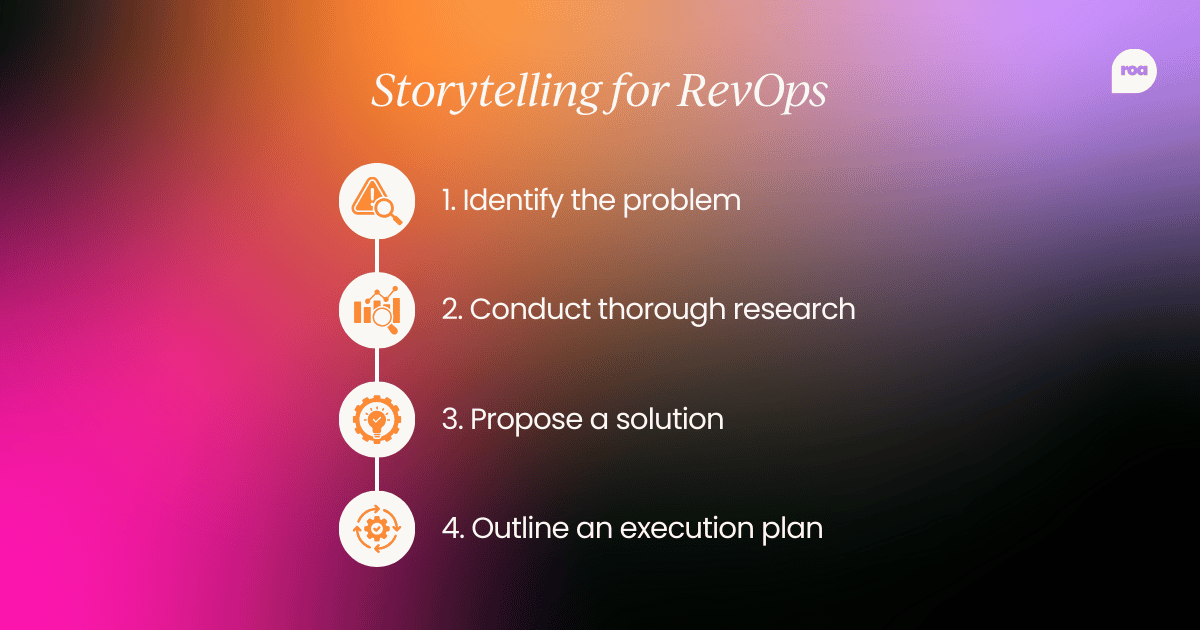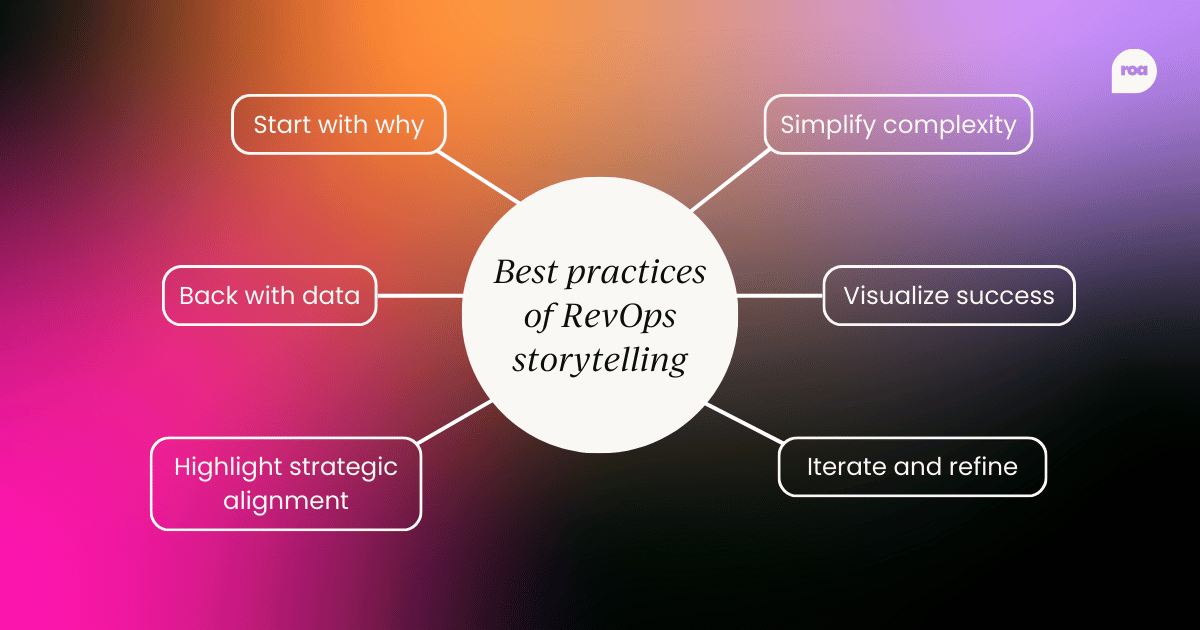In the realm of revenue operations (RevOps), where success hinges on aligning sales, marketing, and customer success efforts to maximize revenue, storytelling emerges as a crucial skill.
It’s not merely about presenting data or outlining strategies; effective storytelling can be the difference between project buy-in and dismissal, ensuring every initiative resonates from inception to execution.
Let’s dive into:
- The importance of narrative
- Constructing the full story
- The power of context
- Tailoring storytelling to different audiences
- An example of successful storytelling
- Crafting your narrative
The importance of narrative
A good narrative is like a hidden revenue multiplier. It doesn't just convey information; it aligns emotions, motives, and actions toward a common goal.
This sentiment underscores the pivotal role storytelling plays in RevOps. When stakeholders—from frontline representatives to C-suite executives—can see themselves in the narrative of a project, they are more likely to support and champion it.
Every successful project I’ve completed in my career started with a carefully curated narrative. And I mean every project!
Whether it’s a micro-proposal for customer service I created in my first associate role or a company-shifting proposal as the Revenue Strategy leader, I always start with a narrative. Making others understand, care, and buy-in to help is the crux of our roles as organizational strategists.
Seeing the future is useless if you can’t make others see it.

Constructing the full story
After trying countless scientific, and artistic at times, story-building methods, I always come back to this basic framework:
- Identify the problem
- Conduct thorough research
- Propose a solution
- Outline an execution plan
While a fun, easy-to-remember acronym for the process would be great, this method isn’t meant for flashy pop culture. It’s meant to be a tried and true technique for creating a positive organizational impact.

It takes a lot of effort to sit down, do the work, and really think through things before sharing your vision. For that reason alone, most impatient or nascent revenue operators often fail even though the mechanism is so clear and simple.
Presenting a project without a narrative is like presenting a body without a soul. It may have all the parts, but without the cohesive story, it lacks the essence that engages and compels action.
Think about those around you in your company who do a lot of work but don’t create change, make incremental revenue, or compel action. Every organization has them. This methodology is the difference between hardworking and impact-making.
To impact or not to impact… as I’m sure Shakespeare would have said if he were a revenue operator.

Context: The catalyst for understanding
In revenue operations, context is not just complementary; it’ is essential. The common phrase "a text without context is a pretext" comes to mind.
This aphorism underscores that presenting a project devoid of its surrounding context leads to misunderstandings and undermines its potential impact. Context provides the framework through which stakeholders interpret the significance of a project within the broader organizational strategy and market landscape.
Funnily enough, I first came across this saying long before I entered the world of sales. My first exposure came back in my academic years studying late antique-medieval history–that was my undergraduate degree, believe it or not!
In history as in business, a solution with an understood problem is both ineffective and unmotivating; two words a revenue operator never wants to hear.
Tailoring storytelling for different audiences
Effective storytelling in revenue operations must cater to diverse audiences, each with distinct needs and perspectives. For frontline representatives, who are focused on daily operations and client interactions, storytelling serves to bridge the gap between abstract strategies and tangible impacts on their workflows.
Frontline reps don't have time to sift through data sheets or decipher complex strategies. They need a clear, concise narrative that shows them how a project directly improves their efficiency or effectiveness.
On the other hand, executives rely on storytelling to gain quick insights into the strategic rationale and potential ROI of a project. Leaders don't have the bandwidth to delve into every detail. They depend on RevOps experts to distill complex initiatives into compelling narratives that highlight strategic alignment and business impact.
I’ve found the most success acing audience comprehension by spending tons of time with the relevant parties, understanding how they think, what they think, and why they think it.
In my customer operations days, I used to sit on the floor listening to hundreds of calls a week. When I moved into sales, I spent countless days on the road with our account executives selling in doctors’ offices. Even now in my strategy role, I do my best to build and maintain close relationships with colleagues in every department.
However, spending time in the head of executives is equally important. Remember, your job is to convince everyone it’s a real problem and a good idea to fix it how you propose. Revenue operations is the sticky web connecting the top, bottom, and sides of a functional company.

Case study in effective storytelling
Earlier in my strategy career, I faced an interesting problem that nicely embodies this framework. The company was on track to spend hundreds of thousands of dollars over the proceeding few years because of a nuanced corporate infrastructure issue. It was something no one had ever really looked into or even noticed.
Once we did though, it became our job to research the problem, investigate potential solutions, make a proposal, and then implement it. The largest obstacle though was taking a very technical, heady concept (minute corporate entity formation interactions) and conveying it in a digestible and clear format.
After weeks of work, we were able to boil the problem down to a simple one-slide diagram that showed the crux of the issue at hand and the impact not addressing it would cause.
It was simple enough for the uninformed audience yet detailed enough through available link-outs to satiate even the toughest corporate critic. Additionally, we created another simple slide showing the high-level framework of our proposed solution (which ended up being to create 50 small companies–and yes, it’s as wild as you imagine). We included a proposed timeline, short-term cost, and long-term ROI details.
Thankfully, we consequently got the company onboard and began the large project of implementation, which is a whole other fun story in itself. Ask me about it sometime over coffee.
Best practices for crafting your narrative
To harness the power of storytelling in revenue operations, consider the following guidelines:
- Start with why: Clearly articulate the problem your project aims to solve and why it matters to the organization's overall goals.
- Back with data: Ground your narrative in robust research and data analysis to provide evidence of feasibility and expected outcomes.
- Highlight strategic alignment: Connect your project to broader business objectives and market trends to demonstrate its relevance and potential impact.
- Simplify complexity: Break down complex ideas into digestible chunks that resonate with different stakeholders, from frontline reps to senior executives.
- Visualize success: Use storytelling techniques such as anecdotes, visuals, and real-life examples to paint a vivid picture of success post-implementation.
- Iterate and refine: Continuously refine your narrative based on feedback and evolving project dynamics to maintain engagement and alignment.

Conclusion
In conclusion, storytelling is not merely a soft skill but a strategic imperative in revenue operations.
Great vision without great storytelling is irrelevant. A compelling narrative not only communicates vision but also inspires commitment and action across organizational levels.
Organizations that excel in revenue operations often prioritize effective communication and storytelling. Their ability to convey a clear narrative around initiatives enhances collaboration, reduces resistance to change, and accelerates implementation timelines.
It serves as the conduit through which ideas are transformed into action, aligning stakeholders around a shared vision and accelerating the path to revenue growth.
By mastering the art of storytelling—from constructing compelling narratives to tailoring them for diverse audiences—RevOps professionals can elevate their influence, drive project success, and foster a culture of collaboration and innovation within their organizations.
And remember, if a guy with no background in business and a niche understanding of late antique history can do it, you definitely can too!


 7 min read
7 min read
 Follow us on LinkedIn
Follow us on LinkedIn




